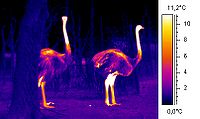
Photo from wikipedia
Elevated temperature was investigated to understand why there is a faster decline in Pratylenchus thornei population abundances in the topsoil than in deeper layers of vertisols after wheat matures in… Click to show full abstract
Elevated temperature was investigated to understand why there is a faster decline in Pratylenchus thornei population abundances in the topsoil than in deeper layers of vertisols after wheat matures in the subtropical grain region of eastern Australia. Soil containing a large population abundance of P. thornei (after wheat growth) was incubated in a replicated experiment for various periods up to 16 weeks at eight temperatures ranging from 10 to 45 °C in 5 °C intervals, with three moisture treatments, namely (a) field capacity maintained during incubation, (b) field capacity allowed to dry during incubation and (c) air-dried before incubation. After incubation, live nematodes were extracted from the soil samples by the Whitehead tray method for 2 and 7 days and P. thornei was counted in four life-stage categories. Temperatures ≥ 35 °C resulted in rapid death of P. thornei independent of any effects due to soil desiccation. At lower temperatures, survival over a 16-week period was better in soil maintained at field capacity than in soil allowed to dry. Death of P. thornei in soil that was air-dried before incubation was rapid during incubation at all temperatures tested. Elevated temperature of itself plus faster soil desiccation with increasing temperature are the likely causes of the faster decline in P. thornei population abundances in the topsoil than in the subsoil. These effects can contribute to soil profile distributions of P. thornei recorded in some fields in this subtropical grain region after clean fallow periods where greater population abundances of P. thornei occur in the subsoil layers than in the topsoil.
Journal Title: Biology and Fertility of Soils
Year Published: 2017
Link to full text (if available)
Share on Social Media: Sign Up to like & get
recommendations!